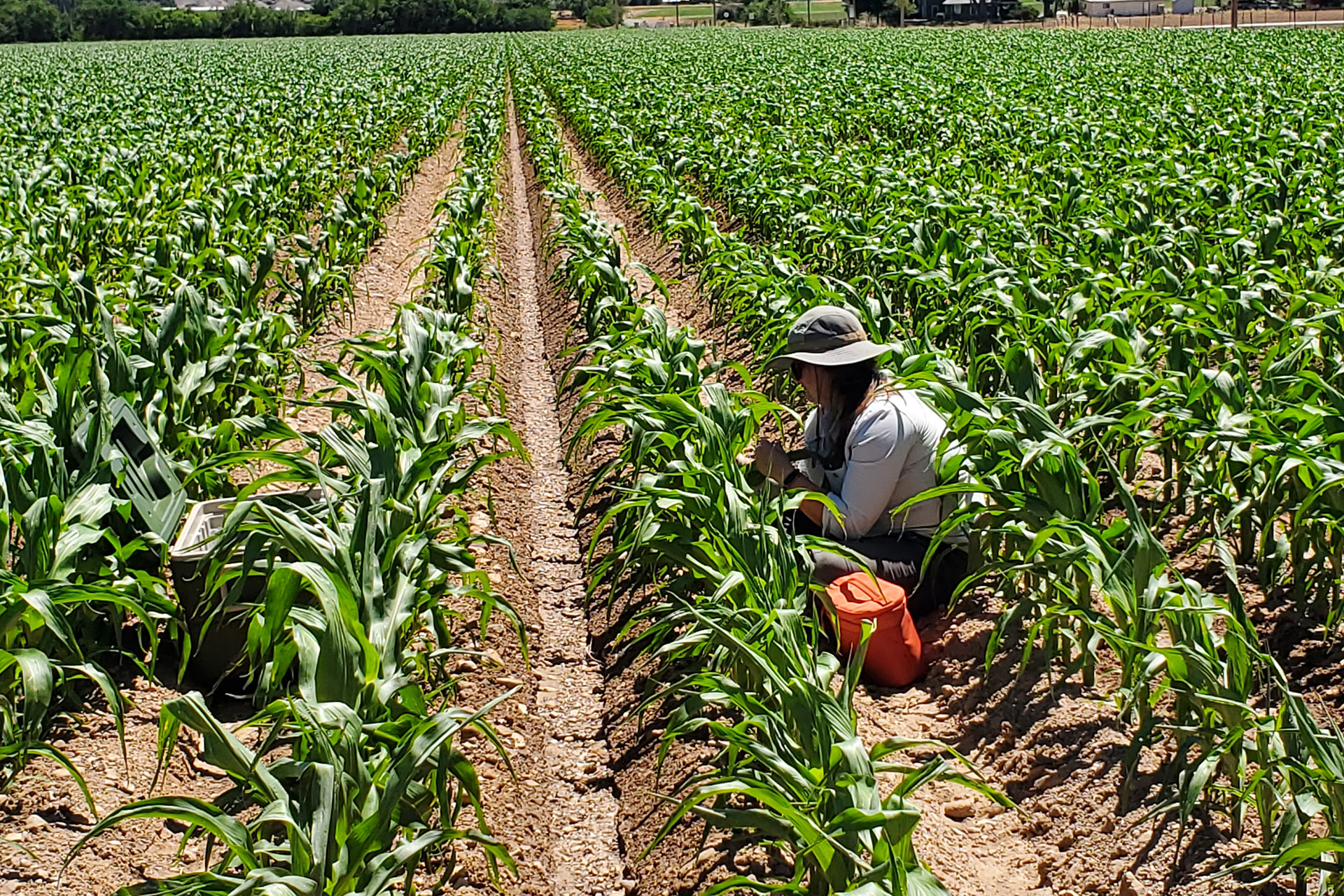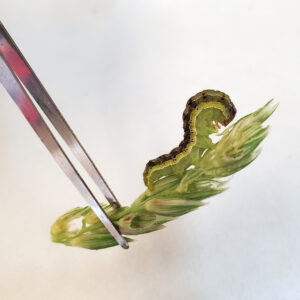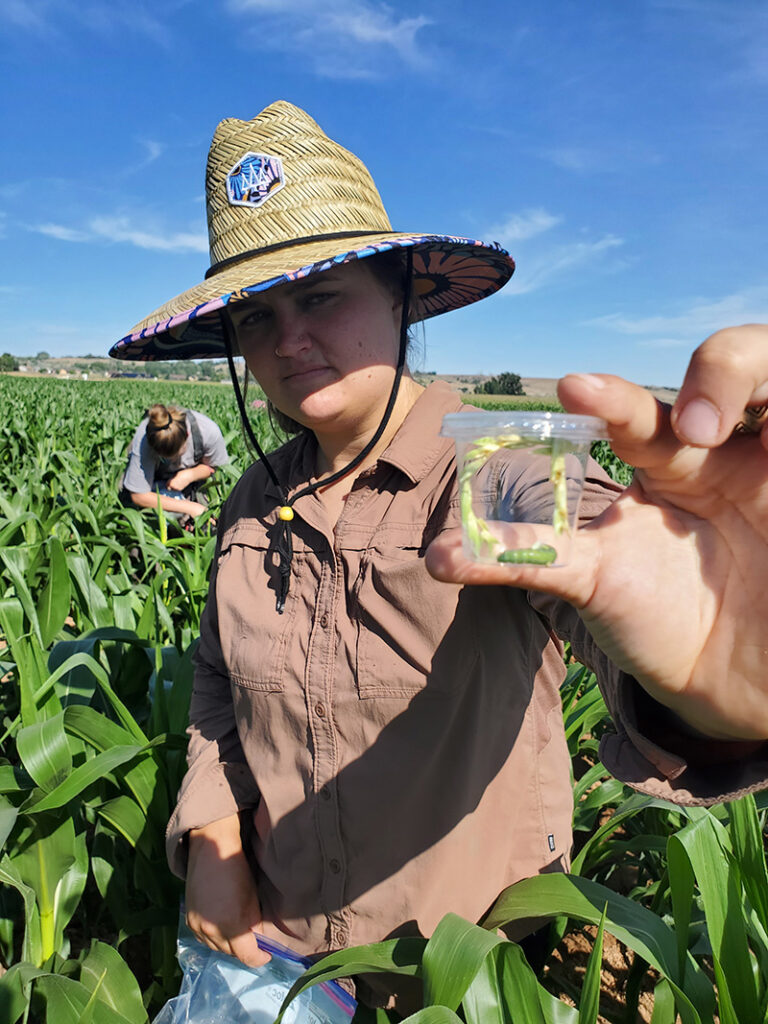
CSU Extension entomologist Melissa Schreiner scouts for corn earworm larvae early in the season in a field in Montrose County. Photo by Melissa Franklin
Not so sweet
Extension entomologist seeks solutions for corn calamity
story by Jayme DeLoss
published Sept. 28, 2023

The corn earworm goes by several names – cotton bollworm and tomato fruitworm among them. Farmers know it as a menace.
This major agricultural pest has decimated this year’s crop of Colorado sweet corn. Colorado State University Extension researchers Melissa Schreiner and Melissa Franklin have been working with growers to understand the corn earworm and how to stop it before it threatens the future of sweet corn in Colorado.
Schreiner is the only Extension entomologist in the state of Colorado, purposefully stationed in western Colorado, near the state’s cash crops, sweet corn and peaches. Franklin has 20 years of experience working with growers in the field. Together, they support community members, Colorado Master Gardeners, producers, Extension staff, and pest management professionals by identifying and educating about insects, and by diagnosing plant damage.
The corn earworm is not a new problem on the Western Slope, but this year was unprecedented for several reasons. Lack of a late spring freeze, followed by a hot July – combined with opportune winds and a well-timed arrival for the corn earworm moth – led to a population explosion early in the season in an area where farmers typically haven’t had to deal with the pest until harvest time. On top of that, the corn earworm has become resistant to pesticides that have controlled it in the past.
“This pest has been a few steps ahead of us the whole time,” Schreiner said.

To gain the upper hand, Schreiner and Franklin plucked larvae from fields to study and tested other potential pesticides. They sent hundreds of moths and larvae to APHIS, the USDA Animal and Plant Health Inspection Service, for genetic testing to ensure they were indeed the corn earworm and not a visually indistinguishable hybrid (which could have been even more devastating).
Almost daily, Schreiner and Franklin have been communicating with growers, packing sheds, crop consultants, chemical companies and the local spray service, which quickly adapted its aerial spraying program based on CSU lab results showing what was working under ideal conditions. Schreiner also has reached out to other areas of the U.S. that more aggressively manage ag lands for the corn earworm.
“CSU Extension entomology is on the front lines, and we’re proud to be helping,” Schreiner said. “But we’re also disappointed that we only have pieces of the answer.”
Schreiner hopes the remaining pieces will fall into place with more research, to help growers stay in the sweet corn business.
SOURCE asked Schreiner a few questions about this unprecedented season and potential solutions.
How bad is the devastation to this year’s sweet corn crop?
It’s been a devastating year for growers, and the battle is not over yet. Certain growers have been hit so significantly by this, they may change their approach to what they’re planting. Some may try again, and I am banking on that because we need to continue to do research. Farmers are resilient, and we will see just how resilient they are this next season. That financial loss is not easy to recover from.
There also was a labor crisis in the Tri-River Area due to this issue. Growers had to keep labor focused on the corn crop instead of moving workers into other cropping systems, like beans, onions or hemp.
Why was the corn earworm especially bad this year?
Many variables caused this crisis. It’s a mix of environmental conditions that were conducive for allowing this pest to thrive, in addition to management and a lack of infrastructure.
There are other areas of the country that are experiencing very high pressure from this pest. In Olathe and Montrose and Delta counties, for a long time we have been somewhat isolated [from the problem]. We deal with this pest annually, but it’s at the end of the season. There’s a lot of preventive measures that need to be taken in terms of scouting protocols – upfront monitoring for this pest – that we lack in our area.
It’s well documented that the corn earworm is capable of developing resistance to pyrethroids. Our preliminary data does show that, unfortunately, some of our tools are no longer effective.
What can be done to save future sweet corn crops?
We need new tools, and it’s challenging to put certain products into play. There are some new insecticides that are working, maybe just not quite as fast as we’d like to see. We hope to study those into future years to figure out exactly what are the protocols we should be following to make these products more efficacious.
I’m partnering with Micky Eubanks [in the College of Agricultural Sciences] on a proposal for a USDA grant that would bring funding to help develop some of the infrastructure needed to prevent this pest, including scouting protocols, new corn varieties, etc. In cotton, they’ve had great success with resistant varieties, so a large component of the project we’ve proposed is looking at new genetics that would make the corn not as tasty to this pest. We also hope to investigate whether these transgenic varieties taste the same to Colorado consumers as heritage varieties by conducting taste testing at the Spur campus.
There’s additional work to be done in how we’re trapping the corn earworm moth and detecting its movement across the nation. We could be using AI to create models to look at this.
What’s going to happen to the acres upon acres of corn affected by the corn earworm?
It will not be harvested. Growers may use it as silage, sell it to the cattle industry for feed. But labor is stretched so thin that I don’t know if they will even have the labor to attempt to sell it into a new market.
Some growers stopped harvesting because the cost of labor or the cost of spraying the fields was not going to pay out. There may be ways to manipulate the product so it’s not unsellable to grocery stores, but we lack the infrastructure to do that. Plans need to be in place to create that relationship and that sale.
There’s nothing wrong with the corn – it just does not meet the consumer’s expectations due to cosmetic damage. It’s perfectly safe to eat. The consumer in many ways drives this culture of perfection.
Is there anything the consumer can do?
We used to pick the worms out of our apples. We used to pick the earworm out of our corn. How many of us don’t think about where our food comes from and all the inputs that go into raising, distributing and transporting crops to our grocery stores? We need more awareness of where food comes from and what’s going into that production to yield perfect, pest-free produce.
Changing consumer culture is going to be slow, and we need to look at how we can build out more infrastructure in our area to help support these growers in their management against this devastating pest. The farmers that grow our food deserve praise and appreciation.
Read more of The Future of Ag is Now
This special report from SOURCE explores the breadth of multidisciplinary, agricultural work happening at CSU — a place where researchers, students and food producers can all gather around a kind of university-wide table to acknowledge the vital importance of ag in Colorado and beyond.